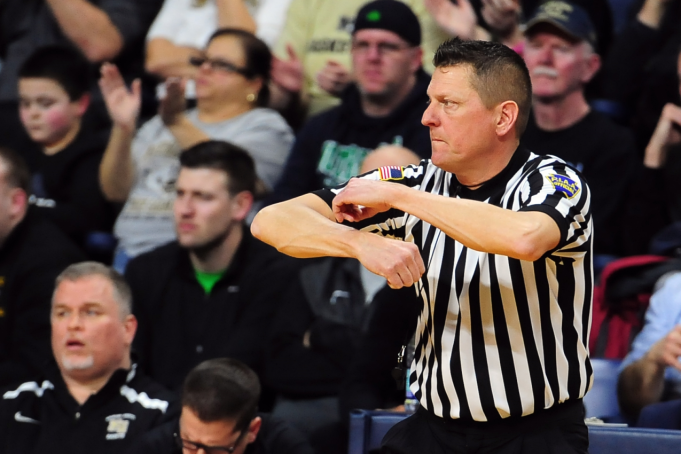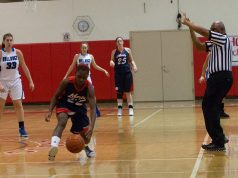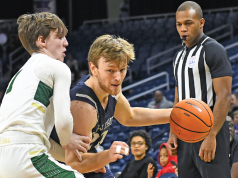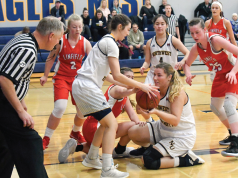When James Naismith invented basketball in the late 19th century, he was looking for a healthy indoor sport to tough out the Northeastern winters. He wanted something that avoided physical contact but involved a good combination of athletic skill and stamina; to help avoid contact, he originally required the ball could only be advanced by passing. Dribbling came later and traveling became a violation that limited players’ ability to run with the ball.
Sounds simple enough, but recognizing and calling traveling is arguably the single most-challenging call to make consistently during a game. The speed, agility and unexpected reactions of players can make the task feel like counting the blades on a moving fan.
Traveling begins with a definition and then lapses quickly into a philosophical discussion, using words like game interrupter, tickytack and blind SOB. I’m not going to try to persuade you when not to call traveling. Instead, we’ll first go on a trip through principles and perhaps remind ourselves of a couple of details that might make future plays simpler to cover. A caveat is there are linkages between traveling, double dribbling and carrying the ball that may cause confusion. In this article, we’re concentrating on traveling only.
Traveling is the act of moving the pivot foot illegally.
I have a partner who is as solid and consistent at calling this violation as anyone I know. His mantra is simple: “Look for the pivot foot.” Once he identifies it, he simply watches that foot. (If a coach jumps him about a call, his routine advice is to watch the video and follow the pivot foot like he just did.) As long as the pivot foot stays on the floor over its original position, a player can do just about anything not covered by the criminal code; once he or she moves that foot, however, only three things can happen that aren’t traveling. Understanding the rule, then, breaks down into knowing how the pivot foot is established and what happens once it’s lifted or dragged.
The pivot foot is the first foot touching the floor once a player successfully controls the ball. If both feet are on the floor after catching, either foot can be the pivot foot. Here are some illustrations:
Play 1: A1 catches the ball securely with (a) one foot, or (b) two feet on the floor.
Ruling 1: At the time the ball is caught, in (a), the foot on the floor becomes the pivot foot. In (b), either foot may be lifted and the one remaining on the floor becomes the pivot foot.
Play 2: A1 catches the ball securely while airborne and lands (a) on one foot followed by the other, or (b) on both feet.
Ruling 2: In (a), the first foot to touch the floor after the catch becomes the pivot foot. In (b), since the feet touched at the same time, either can become the pivot foot.
We frequently see airborne players today catch the ball, landing one-foot-other-foot and they’re allowed to establish either as a pivot foot, which is technically incorrect.
Play 3: Same as Play 2, but A1 bobbles the ball before finally squeezing it after both feet have returned to the floor.
Ruling 3: Before a player can travel, he or she must have first held the ball. Therefore, a player could move several steps, bobbling the ball without holding it, before establishing a pivot foot and without violating. In this play, once the ball is caught, the rulings of Play 1 apply.
Play 4: A1 (a) intercepts a team B pass, or (b) catches an inbounds pass from A2, and lands with one foot in team A’s frontcourt, followed by the other foot in the backcourt.
Ruling 4: Some will say the pivot foot doesn’t matter because A1 has violated, which isn’t true; both plays are legal (NFHS 9-9-3; NCAAM/W 9-12.8, 9-12.9). The point here is those rules don’t change anything about establishing the pivot foot, so the ruling in Play 2 still applies.
Play 5: A1 catches the ball with one foot on the floor, or while airborne, landing on one foot. A1 then jumps off that foot and lands (a) with both feet simultaneously, or (b) on one foot followed by the other.
Ruling 5: A jump stop is being described here and is the legal play of catching the ball on one foot (which could be the pivot foot, as in Plays 1 and 2) and then jumping to land on two feet simultaneously; this is the first of the three good things that can happen after lifting the pivot foot. The tradeoff is that once two feet have touched the floor in a jump stop, neither can be the pivot foot. Legal play in (a) and traveling in (b) since A1 established a pivot foot, lifted it and returned it to the floor as not part of a jump stop. A common situation where you
The main thing that makes traveling hard to understand for some people is the rather challenging way the rules covering it are worded.
want to watch for this is a player picking up the dribble in the lane and hopscotching toward the basket for a shot. Note also, a jump stop is only legal when from one foot to two — not two feet to two, as many players seem to do when catching a perimeter pass and then setting up to take a jump shot.
Play 6: A1 is dribbling the ball while running and then picks up the dribble.
Ruling 6: The same rulings as above apply, no matter how A1 catches the ball: How many feet are on the floor when the ballhandler catches the dribble and what does the player do afterward? OK, we’ve covered how to find the pivot foot. Now let’s look at how moving it results in traveling. We already know one legal way of moving it is via the jump stop, in Play 5. Simply lifting the pivot foot is never traveling; what happens next might be.
Play 7: A1 establishes the left foot as the pivot foot. A1 then lifts it and (a) returns it to the floor, (b) passes to A2, (c) shoots, or (d) initiates a dribble.
Ruling 7: In (a), lifting the pivot foot and returning it to the floor is traveling, as would be dragging the pivot foot to a new location. Both (b) and (c) are the other two legal outcomes of lifting the pivot foot, as awkward as they might sometimes look. These differ from (d), which is traveling. The reason for the distinction is that a player might attempt (b) or (c) and then “bail out” by attempting (d), which is unfair.
There you have it, folks: traveling explained. To be thorough, though, there are one or two other odds and ends to think about regarding traveling.
Play 8: While standing and holding the ball, A1 (a) touches the floor with one hand, (b) touches the floor with one knee, or (c) falls to the floor.
Ruling 8: Action (a) is legal. Action (b) is traveling according to NFHS rules, as a player holding the ball can subsequently touch the floor with a hand or the ball, but no other part of the body, but legal in NCAAM/W so long as the pivot foot is maintained. Action (c) is traveling.
But what if A1 catches the ball while already on the floor? Say A1 catches or recovers the ball while touching the floor with other than a hand or foot. A1 can be lying still, diving into a tangle of legs or sliding along the floor. A1 can also catch the ball airborne and hit the floor other than feet-first. In all these cases, A1’s feet either never touch the ground to establish a pivot foot or what would be the pivot foot, if A1 was standing, moves. The feet are irrelevant when the player is on the ground. It becomes a violation for traveling only if A1 rolls over (front to back, or vice versa) or stands up. That leaves a lot of leeway in between.
The main thing that makes traveling hard to understand for some people is the rather challenging way the rules covering it are worded; certainly, if the rulebook was written the way this article explains traveling, it would leave unintended loopholes. It would, however, make 95 percent of all the situations you’ll see easy to identify and penalize correctly; you can be ready for the others as special cases.
Know what the pivot foot is, find it, then watch what it does. Before you know it, calling traveling will become one of your strengths.
Tim Sloan, Davenport, Iowa, is a high school football, basketball and volleyball official, and former college football and soccer official.
What's Your Call? Leave a Comment:
Note: This article is archival in nature. Rules, interpretations, mechanics, philosophies and other information may or may not be correct for the current year.
This article is the copyright of ©Referee Enterprises, Inc., and may not be republished in whole or in part online, in print or in any capacity without expressed written permission from Referee. The article is made available for educational use by individuals.



















